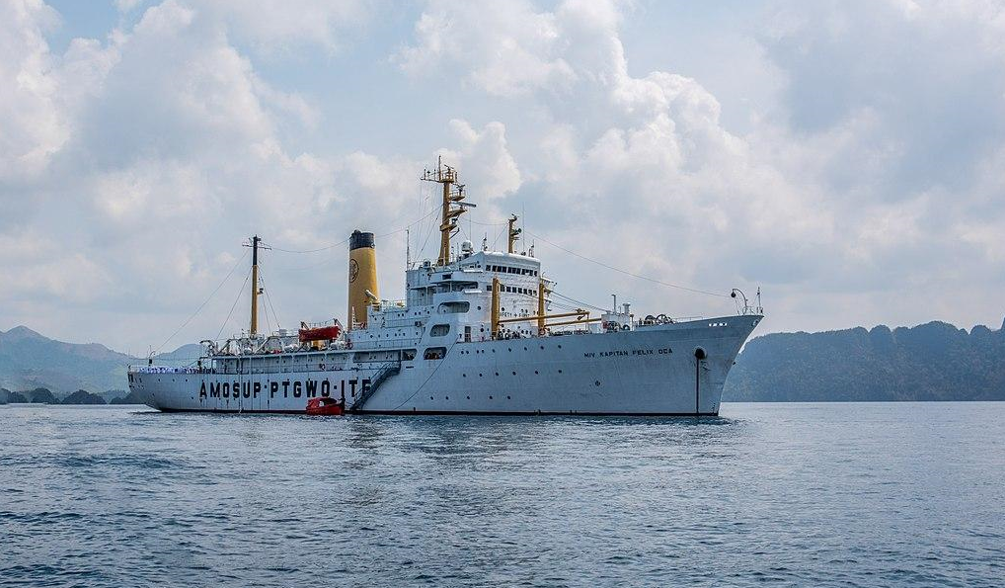Freedom of Navigation

By Manuel Mogato | Date 01-01-2024
A training ship, TS Kapitan Felix Oca, carrying civilian volunteers, local and foreign media representatives, aborted its mission to sail to features occupied by the Philippines in the Spratly Islands early this week when two Chinese navy vessels and a Chinese Coast Guard vessel shadowed the 114-meter-long Filipino civilian vessel.
Fortunately, another, but smaller, civilian ship loaded with “Christmas goods” slipped through the Chinese blockade and reached Lawak Island, or Nanshan Island, about 98 miles east of the main Philippine feature, Thitu Island or Pagasa Island.
In 1968, the Philippines occupied Lawak Island, a nearly eight-hectare bird sanctuary in the South China Sea, where the Philippine Coast Guard had built lighthouses and the military built structures to house a handful of Marines to guard Lawak and nearby Patag Island, or Flat Island, another bird sanctuary six miles north-northeast of the island.
Lawak is the fourth largest of nine features occupied by the Philippines and the eight largest natural island in the entire Spratly chain of islands.
At 5 a.m. on Monday, ML Chowee reached Lawak Island unloading “gifts” donated by big companies and individuals from a civic group, “Atin Ito.”
However, the “mother ship,” TS Kapitan Felix Oca, was forced to return to El Nido, Palawan after Chinese ships made dangerous maneuvers, nearly colliding with a Philippine Coast Guard vessel, BRP Melchora Aquino, which was escorting the civilian convoy.
The civilian ship captain should not be blamed when it made the decision to abort the mission. He could only be concerned about the safety of dozens of journalists and civilian volunteers aboard the training ship.
Perhaps, it was the first time he had experienced such harassment from China’s People’s Liberation Army-Navy (PLA-N) and the Chinese Coast Guard (CCG).
It was pretty scary for the ship captain when a CCG vessel tried to cross the path of BRP Melchora Aquino, a 98-meter Philippine Coast Guard vessel built by Japan. Earlier in the day, Chinese Coast Guard vessels fired water cannons on civilian supply vessels carrying out a “rotation and resupply (RORE)” mission on Second Thomas Shoal or Ayungin shoal where BRP Sierra Madre had ran aground in 1999.

One of the supply vessels was damaged by the water cannon incident while another vessel was rammed by a steel-hulled Chinese ship.
Gen. Romeo Brawner, the military chief of staff, was onboard one of the supply vessels. He was the first top military commander to board the rusting naval transport vessel.
The incidents near Ayungin Shoal could have added fears on TS Kapitan Felix Oca’s captain.
The Chinese Coast Guard could have also used a water cannon on TS Kapitan Felix Oca and larger Chinese militia vessels could have blocked its path.
The Philippines had counted more than 40 Chinese vessels around Second Thomas and Sabina shoals, enough vessels to block the “Christmas convoy.”
Some of the Chinese vessels went dark, shutting off their transponders to prevent the Philippines from tracking their movements in the West Philippine Sea.
The presence of China’s PLA-N vessels in Sabina Shoal, which shadowed TS Kapitan Felix Oca, was not unusual but it was the first time two naval vessels shadowed a civilian vessel.
Based on its “cabbage strategy,” there would always be a Chinese naval vessel in the South China Sea. It could be lurking behind militia and coast guard vessels.
China would always use militia and coast guard vessels to “bully” smaller vessels from other claimant states, like the Philippines.
It rarely used powerful naval vessels. The PLA-N vessels were deployed to shadow navy ships from the United States, Australia, Canada, France, Japan, and the United Kingdom when they embarked on “freedom of navigation” patrols (FONOPs) in the Spratly and Paracels.
The Western naval vessels usually sail within 12 nautical miles of Chinese occupied features, like Fiery Cross Reef and Mischief Reef in the Spratlys, challenging China’s expansive claim on the South China Sea.
They also supported the landmark legal ruling won by the Philippines in the Permanent Court of Arbitration in 2016, repudiating China’s nine-dash-line claims on the South China Sea.
The captain of TS Kapitan Felix Oca should have continued sailing until it reached Lawak Island to unload about two-thirds of the “Christmas gifts” intended to local troops stationed in the occupied features.
China has no right to harass TS Kapitan Felix Oca which was sailing within the Philippines’ 200-nautical-mile exclusive economic zone (EEZ).
The Philippines has sole jurisdiction over its EEZ in the West Philippine Sea.
Additionally, the TS Kapitan Felix Oca could invoke innocent passage within the EEZ on its way to Lawak Island.
The Chinese navy would not take any stupid action against a civilian vessel. Its coast guard could not also stop TS Kapitan Felix Oca because it was not a threat.
Unless the ship was headed to a critical area, like Ayungin Shoal, China would not dare stop TS Kapitan Felix Oca.
In the past, the Philippines did not experience any harassment when conducting “RORE” missions on its occupied features.
China was only concerned about two areas — Second Thomas Shoal (Ayungin) and Scarborough Shoal (Panatag).
It would block and prevent any attempt by the Philippines to transport supplies to BRP Sierra Madre and fish inside the lagoon of Bajo de Masinloc.
“Atin Ito” could attempt another convoy to the Spratly Islands next year when the weather improves — the winds would be less fiercer and the waves not so rough.
But this time, the ship captain must be well aware of the Philippines’ rights to “freedom of navigation” in the West Philippine Sea.
The “freedom of navigation” allows military and civilian vessels to sail anytime, unhampered in the West Philippine Sea.
It does not require the Philippines to ask permission from any state to sail within its EEZ.
It can also bring materials to repair BRP Sierra Madre because no state has sovereignty over the area.
But the Philippines has sovereign rights under the United Nations Convention on the Law of the Sea (Unclos) to explore and exploit resources within the EEZ.
“Atin Ito” needs courageous ship captains to sail within the country’s EEZ and help deliver “gifts’ to Philippine-occupied features without fear of harassment.
China’s navy would only shadow but not intentionally attack a civilian vessel.
